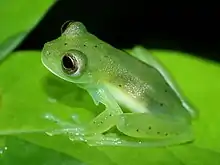Andes giant glass frog
The Andes giant glass frog (Espadarana andina) is a species of frog in the family Centrolenidae. It is found in the Cordillera Oriental of Colombia and the Mérida Andes and Serranía del Perijá of Venezuela.[2]
| Andes giant glass frog | |
|---|---|
 | |
| Scientific classification | |
| Kingdom: | Animalia |
| Phylum: | Chordata |
| Class: | Amphibia |
| Order: | Anura |
| Family: | Centrolenidae |
| Genus: | Espadarana |
| Species: | E. andina |
| Binomial name | |
| Espadarana andina (Rivero, 1968) | |
| Synonyms[2] | |
| |
Its natural habitats are cloud forests and montane evergreen dry forests. It lives along mountain streams and lays its eggs on vegetation over the streams. It is not considered threatened by the IUCN.[1]
Reproductive patterns
A study conducted in a stream located in the Vereda Agua Blanca, Río Frio River basin in Santander, Colombia, analyzed patterns of reproduction sites in Espadarana andina. The study concluded that preferences for sites used by males to call for females, and for females to oviposit (lay eggs) was not impacted by environmental factors such as transitions to and from rainy and dry seasons, time of day, or month of the year. The study showed that oviposition occurred the most on the invasive plant Hedychium coronarium.[3]
References
- IUCN SSC Amphibian Specialist Group (2020). "Espadarana andina". IUCN Red List of Threatened Species. 2020: e.T54902A85877587. doi:10.2305/IUCN.UK.2020-3.RLTS.T54902A85877587.en. Retrieved 11 November 2021.
- Frost, Darrel R. (2016). "Espadarana andina (Rivero, 1968)". Amphibian Species of the World: an Online Reference. Version 6.0. American Museum of Natural History. Retrieved 14 February 2017.
- Cabanzo-Olarte, Laura (June 1, 2013). "Oviposition, Site Preference, and Evaluation of Male Clutch Attendance in Espadarana andina (Anura: Centrolenidae)". Journal of Herpetology. 47 (2): 314–320. doi:10.1670/11-266. S2CID 85624123 – via Web of Science.
